This year, my school officially adopted a BYOD policy for the students. This is a great step forward, but in a culture that sees cell phones as enemies to education it, lets say, hasn’t been openly embraced. We have gone from the days of “only drug dealers have cell phones at school” to today, when, “only the Amish don’t bring their phones to school.” Unfortunately, many teachers, myself included, haven’t been quick to acknowledge the fact that cell phones are really powerful educational tools. They can be used for simple tasks like doing calculations and referencing dictionaries and thesauri, to more complicated activities like research, interactive activities, QR scavenger hunts, augmented reality, and educational games. Now that is not to say that phones aren’t still a distraction. They are a tool, like a textbook or whiteboard, that are valuable but open to abuse (I’m thinking about the numerous sketches and terse remarks scribbled in the margins of textbooks). Today I want to share a few cell phone centric tools that you can use in the classroom, plus a few ways to manage cell phones when not used in class.
The Tools
Socrative
Socrative is my main tool for LRS. It is easy to set up and allows a wide range of options for creating and administering quizzes. I use it from everything from exit tickets to complete test. Instant results are sent without running to the workroom to run scantrons. Plus, it is harder for students to cheat because it can randomize question and answer choices. I also like that I can download and print nicely formatted copies of the test for those that don’t have access to a device. Below is a rather exhaustive video of the features of Socrative.
Kahoot
ExitTicket
ExitTicket is a new app for me. It does many of the same things as Socrative and Kahoot, but allows you to track student’s progress in more detail and over time. That alone makes it a valuable resource. The short video below gives you an introduction to the app or you can check out their videos at exitticket.org.
Plickers
The Other Tools
Classroom Management When Not Using the Device
- Charging Stations- One thing that I know for sure that entice kids to willingly give up their devices is free charging. A few powerstrips or an expensive charging station will give the kids a reason to put their phones down and keep the out of reach when not needed.
- Shoe hangers-This one can be controversial in the terms that you may not feel comfortable having students put their phones in “your possession” in a shoe hanger, but it keeps it out of their reach.
- Tupperware- Place small “phone size” tupperware (preferably disposable) on each student desk. It is helpful to attach the containers to the desk using double-sided tape or velcro. At the beginning of class the kids put their phones in the container and seal the lid. They cannot break the seal on the lid without effort and noise, thus keeping the device out of reach.
- Facedown method- This one is super simple and doesn’t require you to purchase anything. When the student sits down they are to place their phone face down on the corner of their desk. If they touch it, you take it. For groups, have them stack the phones, one on top of the other, in the center of the group.
